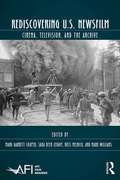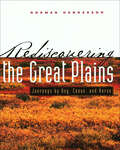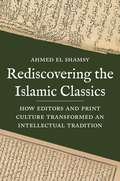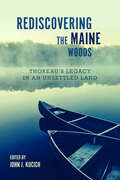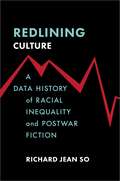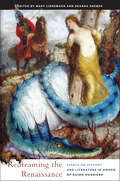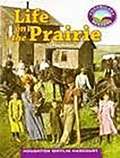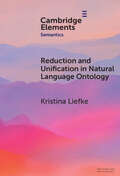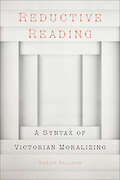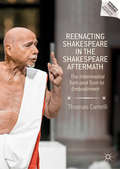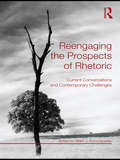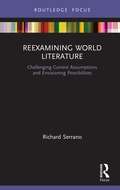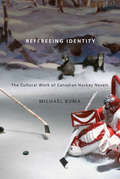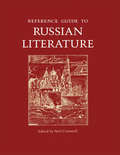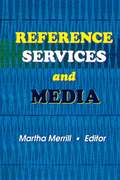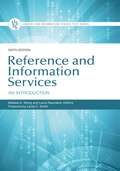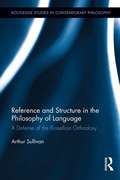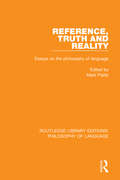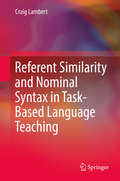- Table View
- List View
Rediscovering U.S. Newsfilm: Cinema, Television, and the Archive (AFI Film Readers)
by Mark Williams Ross Melnick Mark Garrett Cooper Sara Beth LevavyThe twentieth century generated tens of thousands of hours of American newsfilm but not the scholarly apparatus necessary to analyze and contextualize them. Assembling new approaches to the study of U.S. newsfilm in cinema and television, this book makes a long overdue critical intervention in the field of film and media studies by addressing the format’s inherent intermediality; its mediation of "events" for local, national, and transnational communities; its distinctive archival legacies; and, consequently, its integral place in film and television studies more broadly. This collection brings fresh, contemporary methodologies and analysis to bear on a vast amount of material that has languished in relative obscurity for far too long.
Rediscovering the Great Plains: Journeys by Dog, Canoe, and Horse (Creating the North American Landscape)
by Norman Scott HendersonEngaging travel memoir recounts author's adventures traveling in Canada's Qu'Appelle River Valley via horse, canoe, and Native American dogsled.The North American Plains are one of the world's great landscapes—perhaps the signature landscape of the continent. Today, the most intimate experience most of us have of the great grasslands is from behind the window of a car or train. It was not always so. In the earliest days, Plains Indians traveled on foot across the vastness, with only the fierce, wolflike Plains dogs as companions. Later, with the arrival of the Europeans, horses and canoes appeared on the Plains. In Rediscovering the Great Plains, Norman Henderson, a leading scholar of the world's great temperate grasslands, revives these traditional modes of travel, journeying along 200 miles of Canada's Qu'Appelle River valley by dog and travois (the wooden rack pulled by dogs and horses used by Native Americans to transport goods), then by canoe, and finally by horse and travois.Henderson interweaves his own adventures with the exploits of earlier Plains travelers, like Lewis and Clark, Francisco Coronado, La Vérendrye, and Alexander Henry. Lesser-known experiences of the fur traders and others who struggled to cross this strange and forbidding landscape also illuminate the story, while Henderson's often humorous description of his attempts to find and train old Plains breeds of dogs and horses highlight the difficulties involved in recreating archaic travel methods. He also draws on the history of the world's other great temperate grasslands: the South American pampas and the Eurasian steppes. Recalling the work of Ian Frazier and Jonathan Raban, Henderson's captivating account of his three journeys of exploration will foster a better appreciation for, and deeper understanding of, the natural and human history of the North American Plains.
Rediscovering the Islamic Classics: How Editors and Print Culture Transformed an Intellectual Tradition
by Ahmed El ShamsyThe story of how Arab editors of the late nineteenth and early twentieth centuries revolutionized Islamic literatureIslamic book culture dates back to late antiquity, when Muslim scholars began to write down their doctrines on parchment, papyrus, and paper and then to compose increasingly elaborate analyses of, and commentaries on, these ideas. Movable type was adopted in the Middle East only in the early nineteenth century, and it wasn't until the second half of the century that the first works of classical Islamic religious scholarship were printed there. But from that moment on, Ahmed El Shamsy reveals, the technology of print transformed Islamic scholarship and Arabic literature.In the first wide-ranging account of the effects of print and the publishing industry on Islamic scholarship, El Shamsy tells the fascinating story of how a small group of editors and intellectuals brought forgotten works of Islamic literature into print and defined what became the classical canon of Islamic thought. Through the lens of the literary culture of nineteenth- and twentieth-century Arab cities—especially Cairo, a hot spot of the nascent publishing business—he explores the contributions of these individuals, who included some of the most important thinkers of the time. Through their efforts to find and publish classical literature, El Shamsy shows, many nearly lost works were recovered, disseminated, and harnessed for agendas of linguistic, ethical, and religious reform.Bringing to light the agents and events of the Islamic print revolution, Rediscovering the Islamic Classics is an absorbing examination of the central role printing and its advocates played in the intellectual history of the modern Arab world.
Rediscovering the Maine Woods: Thoreau's Legacy in an Unsettled Land
by John J. KucichThe Maine Woods, vast and largely unsettled, are often described as unchanged since Henry David Thoreau's journeys across the backcountry, in spite of the realities of Indian dispossession and the visible signs of logging, settlement, tourism, and real estate development. In the summer of 2014 scholars, activists, members of the Penobscot Nation, and other individuals retraced Thoreau's route. Inspired partly by this expedition, the accessible and engaging essays here offer valuable new perspectives on conservation, the cultural ties that connect Native communities to the land, and the profound influence the geography of the Maine Woods had on Thoreau and writers and activists who followed in his wake. Together, these essays offer a rich and multifaceted look at this special place and the ways in which Thoreau's Maine experiences continue to shape understandings of the environment a century and a half later. Contributors include the volume editor, Kathryn Dolan, James S. Finley, James Francis, Richard W. Judd, Dale Potts, Melissa Sexton, Chris Sockalexis, Stan Tag, Robert M. Thorson, and Laura Dassow Walls.
Redlining Culture: A Data History of Racial Inequality and Postwar Fiction
by Richard Jean SoThe canon of postwar American fiction has changed over the past few decades to include far more writers of color. It would appear that we are making progress—recovering marginalized voices and including those who were for far too long ignored. However, is this celebratory narrative borne out in the data?Richard Jean So draws on big data, literary history, and close readings to offer an unprecedented analysis of racial inequality in American publishing that reveals the persistence of an extreme bias toward white authors. In fact, a defining feature of the publishing industry is its vast whiteness, which has denied nonwhite authors, especially black writers, the coveted resources of publishing, reviews, prizes, and sales, with profound effects on the language, form, and content of the postwar novel. Rather than seeing the postwar period as the era of multiculturalism, So argues that we should understand it as the invention of a new form of racial inequality—one that continues to shape the arts and literature today.Interweaving data analysis of large-scale patterns with a consideration of Toni Morrison’s career as an editor at Random House and readings of individual works by Octavia Butler, Henry Dumas, Amy Tan, and others, So develops a form of criticism that brings together qualitative and quantitative approaches to the study of literature. A vital and provocative work for American literary studies, critical race studies, and the digital humanities, Redlining Culture shows the importance of data and computational methods for understanding and challenging racial inequality.
Redrawing the Map of Early Modern English Catholicism
by Lowell GallagherThe tumultuous climate of early modern England had a profound effect on its Catholic population's domestic life, social customs, literary inventions, and political arguments. Redrawing the Map of Early Modern English Catholicism explores the broad spectrum of the early modern English Catholic experience, presenting fresh and often startling assessments of the most problematic topics in post-Reformation English Catholicism. The contributors to this volume - all leading or rising scholars of early modern studies - conceptualize English Catholicism as a hazardous series of contested territories divided by shifting boundaries, requiring Catholics to navigate with vigilance and diplomacy their status as 'insiders' or 'outsiders.' This collection also presents new ways to understand the connections between reformist and Catholic inflections in the emerging canon of English poetry, despite the eventual marginalization of Catholic poets in English literary history. Redrawing the Map of Early Modern English Catholicism ably demonstrates the profoundly experimental as well as recuperative character of early modern English Catholicism.
Redreaming the Renaissance: Essays on History and Literature in Honor of Guido Ruggiero (The Early Modern Exchange)
by Albert Russell Ascoli Paula Findlen Joanne M. Ferraro Nicholas Terpstra Suzanne Magnanini Konrad Eisenbichler Courtney Quaintance Meredith K. Ray Alessandro Arcangeli Massimo Rospocher Julia L. Hairston Douglas G. BiowRedreaming the Renaissance seeks to remedy the dearth of conversations between scholars of history and literary studies by building on the pathbreaking work of Guido Ruggiero to explore the cross-fertilization between these two disciplines, using the textual world of the Italian Renaissance as proving ground. In this volume, these disciplines blur, as they did for early moderns, who did not always distinguish between the historical and literary significance of the texts they read and produced. Literature here is broadly conceived to include not only belles lettres, but also other forms of artful writing that flourished in the period, including philosophical writings on dreams and prophecy; life-writing; religious debates; menu descriptions and other food writing; diaries, news reports, ballads, and protest songs; and scientific discussions. The twelve essays in this collection examine the role that the volume’s dedicatee has played in bringing the disciplines of history and literary studies into provocative conversation, as well as the methodology needed to sustain and enrich this conversation.
Reduce, Reuse, Recycle (Focus Forward #Green (Levels 12-14))
by Carmel ReillyEvery day, people make a lot of rubbish. But, there are many ways to cut back on a lot of this waste and to help the environment.
Reduced Constructions in Spanish: Linguistics: Reduced Constructions In Spanish (Routledge Library Editions: Linguistics)
by John C. MooreThis book discusses a class of Reduced Constructions which exhibit both mono- and bi-clausal characteristics. In Spanish, as well as other Romance languages, the most salient mono-clausal characteristic is the possibility of clitic climbing, i.e. the possibility of an object clitic attaching to a verb that is higher (in the appropriate sense) than the verb which selects the object to which the clitic corresponds. Reduced constructions come in essentially two varieties: clause reduction (or restructuring) constructions and union (or causative / perception verb)constructions. There has been a good deal of work on a number of aspects of reduced constructions; here the author discusses work in three areas: the analysis of pronominal clitics, the structure of clause reduction and union constructions (and how these treatments interact with the analysis of clitics to yield an account of clitic climbing), and the encoding of embedded subjects in union constructions.
Reduction and Unification in Natural Language Ontology (Elements in Semantics)
by Kristina LiefkeSemantic theories for natural language assume many different kinds of objects, including (among many others) individuals, properties, events, degrees, and kinds. Formal type-theoretic semantics tames this 'zoo' of objects by assuming only a small number of ontologically primitive categories and by obtaining the objects of all other categories through constructions out of these primitives. This Element surveys arguments for this reduction of semantic categories. It compares the ontological commitments of different such reductions and establishes relations between competing foundational semantic ontologies. In doing so, it yields insights into the requirements on minimal semantic ontologies for natural language and the challenges for semantic ontology engineering.
Reductive Reading: A Syntax of Victorian Moralizing
by Sarah AllisonHow practices from the digital analysis of texts both simplify and enhance traditional literary criticism.Honorable Mention, NAVSA Best Book of the Year by the North American Victorian Studies AssociationWhat is to be gained by reading George Eliot’s Middlemarch from an Excel spreadsheet, or the novels of Charles Dickens through a few hundred dialogue tags—those he said/she saids that bring his characters to life? Sarah Danielle Allison’s Reductive Reading argues that the greatest gift the computational analysis of texts has given to traditional criticism is not computational at all. Rather, one of the most powerful ways to generate subtle reading is to be reductive; that is, to approach literary works with specific questions and a clear roadmap of how to look for the answers. Allison examines how patterns that form little part of our conscious experience of reading nevertheless structure our experience of books. Exploring Victorian moralizing at the level of the grammatical clause, she also reveals how linguistic patterns comment on the story in the process of narrating it. Delving into The London Quarterly Review, as well as the work of Eliot, Dickens, Elizabeth Barrett Browning, Anthony Trollope, William Makepeace Thackeray, and other canonical Victorian writers, the book models how to study nebulous and complex stylistic effects. A manifesto for and a model of how digital analysis can provide daringly simple approaches to complex literary problems, Reductive Reading introduces a counterintuitive computational perspective to debates about the value of fiction and the ethical representation of people in literature.
Reductive Reading: A Syntax of Victorian Moralizing
by Sarah Allison“A masterful integration of digital humanistic approaches and more traditional close-reading methods . . . compelling, persuasive.” —Victorian Studies for the 21st CenturyWhat is to be gained by reading George Eliot’s Middlemarch from an Excel spreadsheet, or the novels of Charles Dickens through a few hundred dialogue tags—those he said/she saids that bring his characters to life? Sarah Danielle Allison’s Reductive Reading argues that the greatest gift the computational analysis of texts has given to traditional criticism is not computational at all. Rather, one of the most powerful ways to generate subtle reading is to be reductive; that is, to approach literary works with specific questions and a clear roadmap of how to look for the answers.Allison examines how patterns that form little part of our conscious experience of reading nevertheless structure our experience of books. Exploring Victorian moralizing at the level of the grammatical clause, she also reveals how linguistic patterns comment on the story in the process of narrating it. Delving into The London Quarterly Review, as well as the work of Eliot, Dickens, Elizabeth Barrett Browning, Anthony Trollope, William Makepeace Thackeray, and other canonical Victorian writers, the book models how to study nebulous and complex stylistic effects.A manifesto for and a model of how digital analysis can provide daringly simple approaches to complex literary problems, Reductive Reading introduces a counterintuitive computational perspective to debates about the value of fiction and the ethical representation of people in literature.“A book that promises to transform the way we read novels.” —Elsie B. Michie, author of The Vulgar Question of Money
Reduplication: Doubling in Morphology
by Sharon Inkelas Cheryl ZollThis groundbreaking new study takes a novel approach to reduplication, a phenomenon whereby languages use repetition to create new words. Sharon Inkelas and Cheryl Zoll argue that the driving force in reduplication is identity at the morphosyntactic, not the phonological level, and present a new model of reduplication - Morphological Doubling Theory - that derives the full range of reduplication patterns. This approach shifts the focus away from the relatively small number of cases of phonological overapplication and underapplication, which have played a major role in earlier studies, to the larger class of cases where base and reduplicant diverge phonologically. The authors conclude by arguing for a theoretical shift in phonology, which entails more attention to word structure. As well as presenting the authors' pioneering work, this book also provides a much-needed overview of reduplication, the study of which has become one of the most contentious in modern phonological theory.
Reel History: The Lost Archive of Juma Sultan and the Aboriginal Music Society (Music / Interview Ser.)
by Stephen FarinaIn this engaging hybrid work—a blend of oral history and graphic novel—Stephen Farina finds "Juma Sultan" in a local phonebook. After an initial meeting at a roadside diner, Juma takes Steve and a fellow researcher to a decrepit barn, which, amazingly, contains a treasure trove of reel-to-reel audio tapes and 16mm films of jam sessions and jazz performances from the 1960s and 1970s. As the men go through the boxes and begin the painstaking process of preservation, Juma recalls the players, places, and time period when free jazz exploded then fused with the political momentum of the Civil Rights era. This true story documents "The Aboriginal Music Society" Archival Project, which was funded by the National Endowment for the Arts. Available exclusively as an e-publication, Reel History's expressive and glowing black-and-white illustrations are augmented by audio clips and haunting silent video from Juma Sultan's unique archive. This is an invaluable history for jazz historians and readers in the digital age.
Reenacting Shakespeare in the Shakespeare Aftermath: The Intermedial Turn and Turn to Embodiment (Reproducing Shakespeare)
by Thomas CartelliIn the Shakespeare aftermath—where all things Shakespearean are available for reassembly and reenactment—experimental transactions with Shakespeare become consequential events in their own right, informed by technologies of performance and display that defy conventional staging and filmic practices. Reenactment signifies here both an undoing and a redoing, above all a doing differently of what otherwise continues to be enacted as the same. Rooted in the modernist avant-garde, this revisionary approach to models of the past is advanced by theater artists and filmmakers whose number includes Romeo Castellucci, Annie Dorsen, Peter Greenaway, Thomas Ostermeier, Ivo van Hove, and New York’s Wooster Group, among others. Although the intermedial turn taken by such artists heralds a virtual future, this book demonstrates that embodiment—in more diverse forms than ever before—continues to exert expressive force in Shakespearean reproduction’s turning world.
Reengaging the Prospects of Rhetoric: Current Conversations and Contemporary Challenges
by Mark J. PorrovecchioReengaging the Prospects of Rhetoric reanimates the debate over the function and scope of rhetoric. Providing a contemporary response to the volume The Prospect of Rhetoric (1971), this volume reconceptualizes that classic work to address the challenges facing the study of rhetoric today. With contributions from today’s leading rhetorical scholars, Reengaging tje Prospects of Rhetoric offers "response" essays to each chapter of the original work. Each scholar uses his/her essay as a forum in which to address three questions: As a historical document, why is this essay important? In terms of contemporary theory and/or practice, what is the significance of the essay? How can the issues raised therein be profitably addressed in the future? These provocative engagements suggest that, while the study of rhetoric has gained much ground in the intervening decades, there is more work to be done to reestablish the primacy of rhetoric in contemporary society. This volume provides students and scholars of rhetoric with a strong foundation in the issues that have shaped contemporary rhetorical theory and criticism. It offers them an accessible introduction to the challenges facing future iterations of rhetorical theory and criticism. As a standalone text or a supplemental resource for undergraduate and graduate courses in the history, theory, and criticism of rhetoric or contemporary rhetorical theory, it will help to shape rhetoric’s future role in communication studies and will foster interdisciplinary dialogues about the topic.
Reexamining World Literature: Challenging Current Assumptions and Envisioning Possibilities
by Richard SerranoSerrano calls for a reassessment of the practice of World Literature with six case studies taken from the Arabic, Chinese, French, German, Korean and Latin American traditions. Although in recent years the field has adopted more inclusive and wide-ranging criteria for college-level anthologies of World Literature, and has seen the collection and publication of critical readers, book-length introductions, and even a history, the theoretical predisposition of most of its practitioners paradoxically has led to a shrinking of its horizons and a narrowing of its vision. Reexamining World Literature asks scholars to look beyond the current dominant definition of World Literature (works in English with broad reach or works in other languages with significant circulation in English translation) in order to engage with a range of complex texts that elude the field’s assumptions. World Literature need not be a we-are-the-world of shared values, but instead should ask readers to question what those values are.
Refereeing Identity
by Michael BumaHockey novels in Canada have emerged and thrived as a popular fiction genre, building on the mythology of Canadian hockey as a rough, testosterone-fuelled bastion of masculinity. However, recent decades have also been a period of uncertainty and change for the game, where players and teams have been exported to the US and traditional gender assumptions in hockey have increasingly been questioned. In Refereeing Identity, Michael Buma examines the ways in which the hockey novel genre attempts to reassure readers that "threatened" traditional Canadian and masculine identities still thrive on the ice. In a period of perceived crisis and flux, hockey novels offer readers the comforting familiarity of earlier times when the game was synonymous with Canada and men were defined by their physical strength. This comprehensive study of Canadian hockey novels draws on history, sport sociology, and literary criticism to challenge assumptions and stereotypes about identity. With the return of the Winnipeg Jets refuelling hockey nationalism and the public debate over hockey violence intensifying, Refereeing Identity is a timely and incisive account of how the game is represented - and misrepresented - in Canadian society.
Reference Guide to Russian Literature
by Neil CornwellFirst Published in 1998. This volume will surely be regarded as the standard guide to Russian literature for some considerable time to come... It is therefore confidently recommended for addition to reference libraries, be they academic or public.
Reference Services and Media
by Linda S KatzGet the most out of your reference information systems and technology!Reference Services and Media meets the information challenges that overwhelm and assist us today with computerization, electronics, and telecommunications changes in the reference services of our libraries. As a professional in the library science field, you will discover innovative theories and researched solutions on many technology problems and challenges such as formatting and compatibility, training of reference professionals and library users, costs, and information have and have nots. With the year 2000 and beyond upon us, emerging technologies afford tremendous opportunities for reference librarians and for improved and enhanced public access to information. In Reference Services and Media you will learn about planning for staffing, troubleshooting fund-raising, and budget developing to support the use of information technologies. You will also examine the impact new media has on academic libraries, specifically video and movie clips that are transferred over intranets and internets and their opportunities and legal implications. In Reference Services and Media you will also explore:desktop conferencing and web access for reference services versus personalized contactdesktop conferencing with personal computers in remote areas for reference service assistancepositive and negative aspects of using each technology in reference use instruction creative methods for procuring funding for an electronic information literary instruction classroomproviding a digital library for a state library networkraising confidence levels of public service librarians in using electronic resources to answer reference questions Reference Services and Media includes case studies, tables, and an annotated bibliography that serves as a librarian's media reference toolkit, making it essential for effective media reference work. An excellent source for the reference librarian, Reference Services and Media will assist you in adopting and incorporating new information technologies for the present and future.
Reference and Information Services: An Introduction (Library and Information Science Text Series)
by Melissa A. Wong Laura SaundersThis new edition of the classic text Reference and Information Services has been thoroughly updated to reflect current information in the field.| This revised and updated sixth edition of Reference and Information Services continues the book's rich tradition, covering all phases of reference and information services with less emphasis on print and more emphasis on strategies and scenarios.| Reference and Information Services is the go-to textbook for MSLIS and i-School courses on reference services and related topics. It is also a helpful handbook for practitioners. Authors include LIS faculty and professionals who have relevant degrees in their areas and who have published extensively on their topics. ||The first half of the book provides an overview of reference services and techniques for service provision, including the reference interview, ethics, instruction, reader's advisory, and services to diverse populations including children. This part of the book establishes a foundation of knowledge on reference service and frames each topic with ethical and social justice perspectives. ||The second part of the book offers an overview of the information life cycle and dissemination of information, followed by an in-depth examination of information sources by types, including dictionaries, encyclopedias, indexes, and abstracts, as well as by broad subject areas including government, statistics and data, health, and legal information. This second section introduces the tools and resources that reference professionals use to provide the services described in the first half of the text.| | Reference and Information Services is a recognized textbook for information retrieval courses and updates the previous edition | Editors and contributors are experts in the field | Activity boxes engage readers and invite them to reflect on what they are learning and to practice skills through real-life exercises | Conscious integration of critical theory and social justice perspectives offers critical reflection on the standards and practices of the field and encourages readers to consider alternate perspectives
Reference and Structure in the Philosophy of Language: A Defense of the Russellian Orthodoxy (Routledge Studies in Contemporary Philosophy)
by Arthur SullivanThis volume investigates the precise contours of the connections between two foundational concepts: reference (the means of semantically expressing singular or object-dependent information) and structure (the having or lacking of meaningful sub-parts). Sullivan shows that the notion of structure, properly excavated, underlies and grounds various important points in the theory of reference. As such, this work builds on and further develops work by Bertrand Russell, Saul Kripke, David Kaplan, and Stephen Neale – principally, among many others. Sullivan aims to clearly establish the intrinsic connections between structure and reference, which brings into focus informative and explanatory connections underlying otherwise disparate debates about various aspects of linguistic communication. The overall result is a simple, comprehensive lens that can help to clarify a wide range of semantic phenomena.
Reference, Truth and Reality: Essays on the Philosophy of Language (Routledge Library Editions: Philosophy Of Language Ser.)
by Mark PlattsThe papers in this collection discuss the central questions about the connections between language, reality and human understanding. The complex relations between accounts of meaning and facts about ordinary speakers’ understanding of their language are examined so as to illuminate the philosophical character of the connections between language and reality. The collection as a whole is a thematically unified treatment of some of the most central questions within contemporary philosophy of language.
Reference: Oxford Surveys in Semantics and Pragmatics
by Barbara AbbottThis book introduces the most important problems of reference and considers the solutions that have been proposed to explain them. Reference is at the centre of debate among linguists and philosophers and, as Barbara Abbott shows, this has been the case for centuries. She begins by examining the basic issue of how far reference is a two place (words-world) or a three place (speakers-words-world) relation. She then discusses the main aspects of the field and the issues associated with them, including those concerning proper names; direct reference and individual concepts; the difference between referential and quantificational descriptions; pronouns and indexicality; concepts like definiteness and strength; and noun phrases in discourse. Professor Abbott writes with exceptional verve and wit. She presupposes no technical knowledge or background and presents issues and analyses from first principles, illustrating them at every stage with well-chosen examples. Her book is addressed in the first place to advanced undergraduate and graduate students in linguistics and philosophy of language, but it will also appeal to students and practitioners in computational linguistics, cognitive psychology, and anthropology. All will welcome the clarity this guide brings to a subject that continues to challenge the leading thinkers of the age.
Referent Similarity and Nominal Syntax in Task-Based Language Teaching
by Craig LambertThis volume addresses an important gap in the literature on task design and second language use. Building on insights from over 50 years of research on the relationship between task demands and language use, it examines how referent similarity relates to developmentally-relevant variation in the use of nominal structures, comparative structures and abstract lexis among first and second language speakers of English. In addition to providing an empirical basis for future research on tasks, it shares both theoretical and practical information on task design, which will greatly benefit curriculum and material developers.
